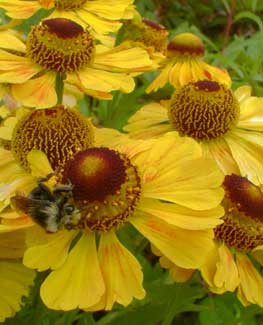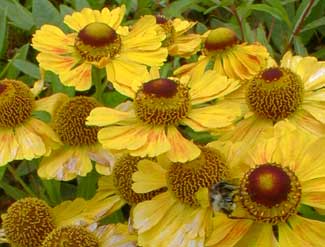
'Feursiegel' Helen's Flower;
or, Sneezeweed
"Let it come
like wildflowers,
suddenly, because the field
must have it: wildpeace."
-Yehuda Amichal
(1924-2000)
(1924-2000)
Helenium x autumnale is a popular perennial in Germany with many varieties developed in the past decade by German growers. Each year it seems another German hybrid variety makes it to the American market.
It's intriguing that Heleniums have long been more popular in Europe than in America, for they are native to North America, where historically they were referred to dismissively as Sneezeweeds. The origin of the name Sneezeweed is uncertain, but it appears that Native American medicine men would grind up the plant, blow it in the faces of individuals thought to be possessed (by devils or diseases), inducing sneezing that was believed to expel the demon (or sickness. European settlers saw how it was used among native peoples, & immediately picked up on it as a substitute for snuff.
Their more favorable name is Helen's Flowers, after Helen of Troy, & because the blossoms are bright as the sun (helios). Helen's flowers require full sun, where they are drought hardy & heat hardy, but also tolerant of moisture. It thrives in regular garden soil & is almost never bothered by pests or diseases. It begins blooming in July & with deadheading of spent flowers will continue flowering until September.
They were introduced into Europe in 1729 & were wowing European garden shows by 1878. Throughout the 19th Century there were no named forms, but a half-dozen species were gardened. By the 1920s select varieties & hybrids were beginning to appear in plant catalogs & flower shows. The first really praiseworthy cultivars were developed by Karl Foerster from the 1940s onward.
 'Feursiegel' is one of Karl Foerster's plants. The name means "Fiery Lightning-bolt." It received the Award of Garden Merit in 2001. The clumps stand three or four feet tall, sometimes taller, topped by a tight bunch of blossoms that have petals gold-tipped with bright red streaking, around a large button center of yellow & red.
'Feursiegel' is one of Karl Foerster's plants. The name means "Fiery Lightning-bolt." It received the Award of Garden Merit in 2001. The clumps stand three or four feet tall, sometimes taller, topped by a tight bunch of blossoms that have petals gold-tipped with bright red streaking, around a large button center of yellow & red.Sneezeweeds have chemical components that function as insecticides so that the plant is not much bothered by pests. They are also not much browsed by wildlife, being toxic to deer & rabbits, as also to livestock.
As medicinal plants, sneezeweeds were cited by Constantine Rafinesque in Medical Flora of the United States (1828) as a cure for deafness, headaches, rheumatism, & congestion. Some of its alleged values, such as curing the deaf, are in the main baseless. But scientific studies of various species of helenium have substantiated a few of the traditional uses, although the plant's toxicity is too great for it to be safely used as a home remedy.
Several chemical components of the genus have interested serious researchers. The chemical helenalin for chief example is a potent anti-inflammatory pain relief medication, anti-tumor agent, & even has a potential for treatment of leukemia [Kasai et al, Journal of Natural Products, 1982]. Unfortunately helenalin has serious toxic side effects that make its use both as an herbal remedy or a pharmaceutical grade extract dangerous especially to the hepatic system. Another isolated chemical, microlenin, has been shown to inhibit cancer growths, & was not as apt to cause cellular damage as was helenalin [Hall et al, The Journal of Pharmacological Science, 1983].
Herbal remedies without actual benefit beyond that of a placebo tend also to have minimal potential for harmful side effects, so are the most popularly promoted by the herbal industry, echinacea for key example, being neither helpful nor harmful, unless used for a treatable condition to avoid actual physicial care. By contrast, herbs with the greatest potential as authentic medicines tend also to have the greater capacity for harmful side-effects, & this is certainly true for the genus Helenium.